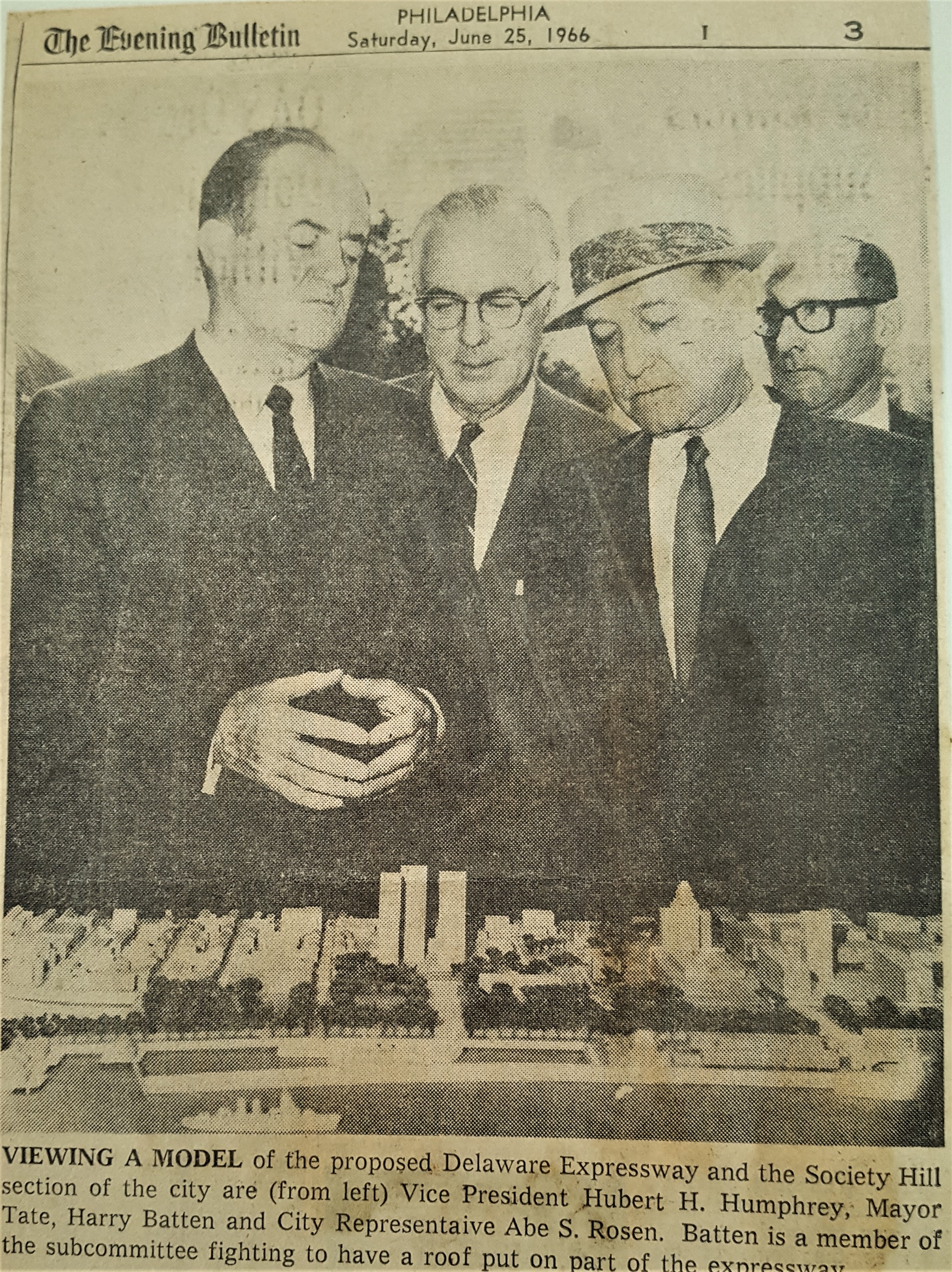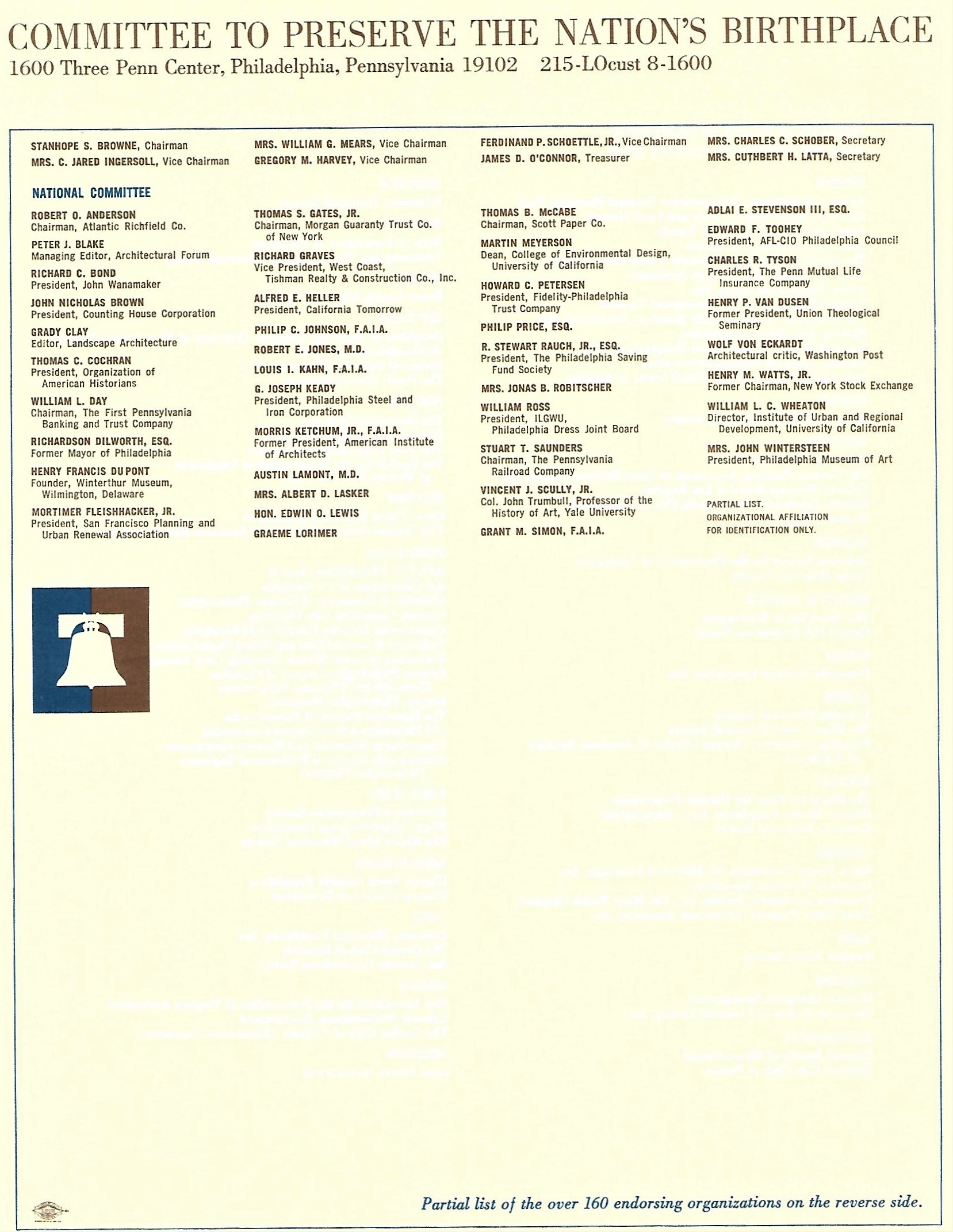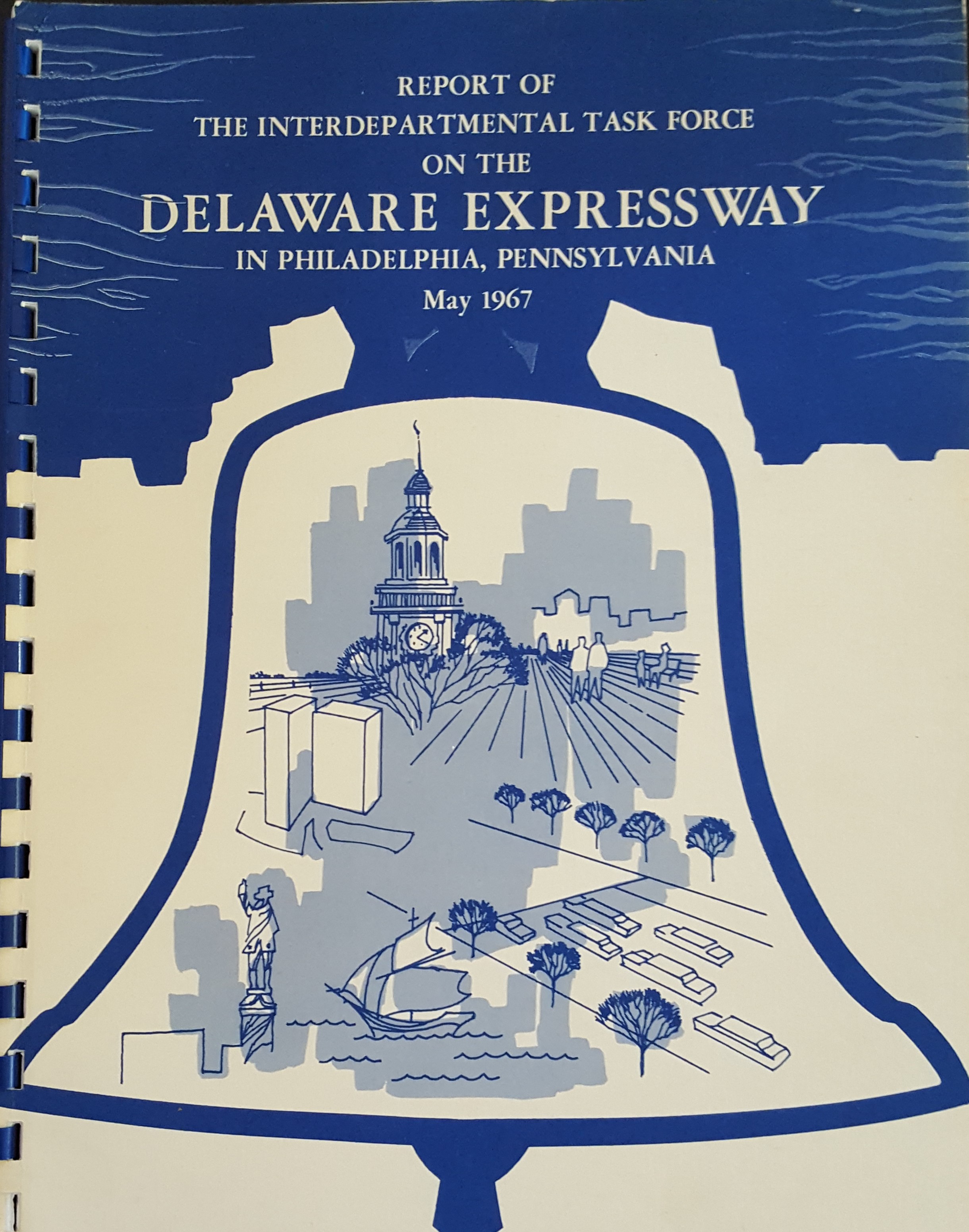A new crisis thus arose, and those in favor of the cover were forced to take a new tack. It was decided not to give up the fight, but to seek alternative financing.
In the meantime, a more fundamental problem faced those concerned with covering the expressway. With the rejection by Secretary Connor of the request for highway funds, the highway people in general felt that the controversy was concluded and gave indication that plans for the open-ditch design were going ahead at full speed. Something had to be done to show that the fight was still on.
On April 6, Senator Clark made a speech on the Senate floor challenging the general policies of the Bureau of Public Roads and indicating that the design of highways in urban areas should be supervised by a watchdog committee of the Secretaries of Commerce, Interior and Housing and Urban Development and perhaps the new Secretary of Transportation. His speech spoke of the problems of urban freeway design as national in scope, but he pointed to the Philadelphia experience as a horrible example. He stated that he would explore the needs for new legislation in this area.
On June 2, he, together with Senator Scott, introduced a bill to solve a particular problem of Philadelphia's expressway area. This bill authorized the extension of Independence National Historical Park to include the entire six-block cover area and authorized expenditure of $25 million for the building of this addition to the park. It was felt that there was little chance that the bill would pass in the form in which it was introduced, particularly in the light of the Vietnam situation. Some possibility was seen for one or two blocks being authorized as part of the national park. However, the mere introduction of the bill would indicate that the open-ditch highway plans should not go ahead.
Meanwhile, back in Philadelphia, Mr. Dilworth was elected president of the Board of Education and could not give his full time to the OPDC effort. R. Stuart Rauch, president of the Philadelphia Saving Fund Society, was called in to take his place as chairman of the OPDC committee. Also, Harry A. Batten, who was 1) chairman of N. W. Ayer advertising agency, 2) largely responsible for starting the Society Hill restoration and 3) a member of the advisory commission to Independence National Historical Park, began to take a personal interest in the fight. He pointed out that the fight must now become a national one and be geared very specifically to INHP. He was instrumental in having a drawing originally prepared by the Architects Committee turned into a much more elaborate representation of the historical features of the area (see the second-to-last image of the brochure in Chapter 4). It was his suggestion that the Gateway Committee turn itself into a national committee and seek endorsement from all over the country.
Martha Schober then obtained from a Washington organization a long list of the most likely possible endorsers. Letters were sent out to all of them during the month of April, with copies of the brochure, asking their endorsements for a national committee. In the meantime, Mr. and Mrs. Ingersoll, Mr. Day, Mr. Watts and others started to gain support from persons on the national scene who would become individual members of the national committee, to lend prestige to the new letterhead. It was determined that the committee would change its name to the Committee to Preserve the Nation's Birthplace.
Safety
Seeing all this activity apparently caused those opposed to the cover to introduce a new issue into the fight. On March 29, Philadelphia's Streets Commissioner David M. Smallwood in a luncheon address charged that the covered expressway road "would be the most dangerous piece of highway ever designed." A paid advertisement appeared in The Evening Bulletin for Monday, April 18; in it, a private individual charged that the Gateway Committee was proposing a $25 million "drive-in coffin" and in a savage attack outlined the supposed dangers of the highway.
The brochure had purposely not contained many statements on this safety issue. It had been our feeling after examination, that there was no safety problem. The noting of this fact alone in the engineer’s report was felt to be sufficient, or else fuel might be added to the few sparks of the safety issue we had heard before. But it was now felt that a public statement should be made and, accordingly, a press release was issued on May 13. The release took the form of a report by Mr. Allabach on the safety issue, couched in layman's terms.
Messrs. Allabach, Weise and I also went up to the offices of Ole Singstad, of Singstad & Kehart in New York City, universally recognized as the world's leading highway tunnel engineers. Mr. Singstad had designed and supervised the construction of the Holland Tunnel, the first vehicular tunnel. A morning's conversation with Mr. Singstad produced a memorandum which he later specifically approved, and which answered in very specific engineering terms most of the safety criticisms which had been made of the tunnel.
There had been no noticeable counter-reaction to the release of Mr. Allabach's statement, and therefore it was felt that the Singstad's statement should be held in reserve as our reply to round two of the safety fight, should that round appear. It never did; and thus, the Singstad statement was never publicized. We had even obtained Mr. Singstad's acceptance of an invitation to come to Philadelphia to appear on a television program on the safety issue, should the need arise.
Washington
The introduction of Senator Clark's bill relating to the national park in his speeches on coordination of government policy had caused certain repercussions at the cabinet level in Washington. On May 12, 1966, Secretary of the Interior Stewart L. Udall announced his approval of the covered concept, although he had no specific financing to offer. Robert C. Weaver, Secretary of Housing and Urban Development, issued a similar statement on June 22, and even offered to help pay for some of the cover.
In the meantime, pressures were being brought at a higher level in Washington. There were a number of efforts, many of them by their very nature rather confidential, and thus I do not know all of the things that were directed at the President and the Vice-President. But I do know a few things.
Most important, early in the spring Senator Clark spoke to Vice-President Humphrey and urged him to do something about the crisis in Philadelphia. He felt that Mr. Humphrey was generally sympathetic to the subject matter of Clark's own April speech on the coordination of highway design and felt that administrative action at the highest level was needed to prevent a mistake being made in Philadelphia. The Vice-President indicated his interest. He anticipated a trip to Philadelphia in the near future and promised to visit the area in question. That visit took place on June 24, 1966. The Architects Committee model was set up in front of the Merchants Exchange Building in INHP. Vice-President Humphrey, accompanied by Mayor Tate and Democratic gubernatorial candidate Milton J. Shapp, examined the model and heard another presentation by Mr. Batten. The Vice-President said that he would have an inter-departmental task force appointed to investigate the problem from the point of view of the Bureau of Public Roads, the Department of the Interior and HUD.
Just about everyone had been suggesting that Mrs. Lyndon B. Johnson could solve our problem because of her pet project, the Highway Beautification Act of 1965. We viewed this advice as rather naïve, since we knew it to be her policy never to involve herself in specific issues. Nevertheless, quite independently, she had been invited to Philadelphia to accept the Society Hill medal during Society Hill Week in June. It was determined that a short presentation would be made to her, so she was shown the model of the cover plan where it was kept in the Society Hill Towers. We heard from absolutely authoritative sources right next to the First Lady that, by one account, she was disgusted by our linking this presentation with an award, it appearing that Philadelphia was offering the award in return for help on the issue. Yet, by another, we heard that she was absolutely sympathetic to our plight, was charmed by the visit, and would do everything she could unofficially to help us, although she could of course never acknowledge this. I do not know which version is true; maybe both were.
A number of other leading Philadelphians offered to use whatever influence they could at the White House level. Some of these were the heads of major corporations and others were in the governmental structure of Philadelphia and the federal government. I heard of intentions to do this and never learned what contacts were actually made.
What we did learn, however, was that on July 25, 1966, Vice-President Humphrey directed HUD Secretary Weaver to appoint a task force to study the issue.
Since we now knew with fair certainty that this task force would go to work, on July 27, we issued a press release on our new stationery announcing the formation of our national committee; the letterhead included a number of very impressive names.
The purpose of the national committee was to gain broad support for what we hoped would be the task force's favorable recommendation. We did not know whether the task force report would call for a purely administrative decision in implementing the cover or would require legislative action (either by Congress, the Pennsylvania Legislature or City Council) or even for electoral action (the approval of bond issues). We did anticipate that some public support would be necessary before the task force recommendations -- if favorable -- could be implemented. Therefore, work was begun on the preparation of a very small leaflet which could be sent to our endorsing organizations throughout the country and would ask members of those organizations to write to the appropriate officials urging the cover. We, of course, did not know what specifically to ask them to do and would not know until the task force report was issued. But we wanted to be ready when the time came, and thus our graphic arts people and our printers were put to work.
Suspense
The task force itself was formed in late August and went to work. The job of feeding it the necessary information was now undertaken by OPDC (principally through Mr. Rafsky), the Gateway Committee and – perhaps the most important – the City of Philadelphia through its Department of Commerce. Mr. Peter Schauffler, Deputy Director of Commerce in charge of Penn's Landing, now become a leading participant in the struggle. The Department of Commerce was able to do what the Gateway Committee had always wanted to do but could not afford: hire real estate marketing consultants to make economic studies of the possible return from commercial uses at the north end of the cover. The architects for Penn's Landing (principally Robert Geddes, partner in a Philadelphia architectural firm and later dean of the School of Architecture at Princeton University) had also by now greatly expanded the range of possibilities of the design of the cover. Instead of our committee's simple six-block proposal, a series of proposals, varying in length from 3-and-one-half to 6 blocks on the Delaware Expressway and with various combinations of covers over Delaware Avenue, were now analyzed and subjected to cost and economic analysis. All of these plans were issued to the task force with suggestions for appropriate funding. In general, it was thought that the expressway cover south of Chestnut Street should be paid for entirely by the federal government, presumably with National Park Service funds. The cover north of Chestnut Street should be paid for in part with highway money (to depress the traffic lanes under the Frankford subway), and in part with urban development money from state and city sources for the cover itself.
Since this separation focused particular attention at the foot of Market Street, a special committee statement on that area was prepared.
Matters then went into a sort of limbo. We had no clear idea of when the task force report would be issued, although rumors kept coming back to us that it was due about one week after we heard the rumor. We had first heard that the draft had been prepared, then that it was on the desk of various subordinate officials, then that it was before the secretaries, and finally, after Christmas, we heard that it was all on the Vice-President's desk. Contradictory newspaper stories kept appearing, some of them promising a six-block cover.
An ominous situation with political overtones had in the meantime developed. Earlier in the fall, the Gateway Committee and its friends in OPDC and the Greater Philadelphia Movement had approached the gubernatorial candidates on both sides, Republican Raymond P. Shafer and Democrat Milton J. Shapp in an effort to obtain their support for the cover. Both candidates individually and in their Philadelphia speeches and both party platforms subsequently called for the cover. In addition, it became clear that the task force was taking as its starting point commitments by the city and state for as much financing as they would be able to contribute. Thus, it became important to obtain the necessary commitments from Mayor Tate and Governor Scranton. Mayor Tate was not much of a problem, although City Planning Commission Director Ed Bacon apparently tried to undo some of his commitments. At the state level, we were able to obtain an October 18 letter from Gov. Scranton pledging $600,000 of state highway money and $4.5 million of General State Authority capital improvement funds.
Then in February of 1967, a newspaper story appeared quoting the new PA Secretary of Highways Robert G. Bartlett as saying that he knew of no commitment by the Commonwealth to pay for the cover, and that in any event, if such a commitment had been made, matters had changed because of a general highway fund cutback. This posed a crisis for our effort, since the taking away of the state commitment might pull down the whole task force effort. Accordingly, the OPDC committee had its first meeting in many months and, particularly, upon the urging of Martha Schober who had been invited to come, it was suggested that an intensive letter-writing campaign now be directed at our new Governor Shafer. No outside publicity was recommended, since such publicity might inform the task force of what Mr. Bartlett was apparently trying to do. As far as we could tell, the task force had not yet heard of Mr. Bartlett's statement. Accordingly, the Gateway Committee went back to work. A barrage of letters arrived on Gov. Shafer's desk. Entreaties were also made through many people who had fairly direct access to the governor. He agreed to come down to Philadelphia to look over the situation, but at the last minute had to cancel the trip.
Meanwhile, we had heard that the task force report was to be issued on March 2 in the Vice-President’s office in Washington and that Senator Clark, Secretary Bartlett and Mayor Tate had been invited to attend. At Mr. Rauch's behest, Governor Shafer arranged for Mr. Schauffler and me to accompany Mr. Bartlett from Harrisburg to Washington the morning of the meeting to fill him in on our side of the case. The ride was particularly fruitful. A number of misunderstandings, particularly on Mr. Bartlett's part, were cleared up. For instance, he had assumed that I was an attorney for the Aluminum Company of America (ALCOA). More important, he did not realize that Philadelphia was willing to shift funds from other Philadelphia highway projects to the cover.
**************
The report that Stanhope wrote in the spring of 1967 about the Gateway fight ends here.
Following the meeting in Washington on March 2nd, the Philadelphians had to wait until May 18, when the Intergovernmental Task Force issued its report in which it approved the proposal to depress the Delaware Expressway and cover it with a four-block “lid.”
Inside the front cover of the Task Force report appeared the following quote :
“The door of discussion will always be open in the federal government to the mayor of every city and the governor of every State. … [We] must pursue and endeavor as best we can to perfect the partnership which enables government to work – the partnership between the Executive Branch and the Congress, between the federal government and the States, between both and the local communities.”
— President Lyndon B. Johnson, Message on the Quality of American Government, March 1967
and inside the back cover of the report:
“[We] must restore… the beauty and charm of our cities. Our conservation must be not just the classic conservation of protection and development, but a creative conservation of restoration and innovation.”
— President Lyndon B. Johnson, Message on Natural Beauty, February 1965
Success at last!


